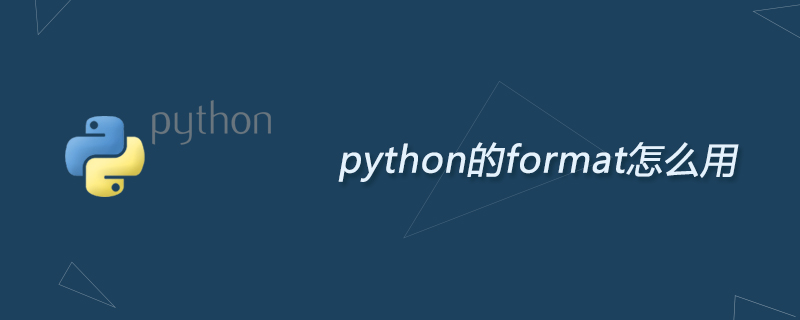

How to use python’s format?
Python’s format function usage
It enhances the string formatting function. The basic syntax is to replace the previous % with {} and :. The format function can accept unlimited parameters, and the positions do not need to be in order.
**Example 1: The **format function can accept unlimited parameters, and the positions do not need to be in order.
"{} {}".format("hello", "world") # 不设置指定位置,按默认顺序
运行结果:'hello world'
"{0} {1}".format("hello", "world") # 设置指定位置
运行结果:'hello world'
"{1} {0} {1}".format("hello", "world") # 设置指定位置
运行结果:'world hello world'Example 2: You can also set parameters.
print("网站名:{name}, 地址 {url}".format(name="Python教程", url="www.py.cn"))
# 通过字典设置参数
site = {"name": "Python教程", "url": "www.py.cn"}
print("网站名:{name}, 地址 {url}".format(**site))
# 通过列表索引设置参数
my_list = ['Python教程', 'www.py.cn']
print("网站名:{0[0]}, 地址 {0[1]}".format(my_list)) # "0" 是必须的
运行结果:
网站名:Python教程, 地址 www.py.cn
网站名:Python教程, 地址 www.py.cn
网站名:Python教程, 地址 www.py.cnExample 3: You can also pass in the object to str.format():
class AssignValue(object):
def __init__(self, value):
self.value = value
my_value = AssignValue(6)
print('value 为: {0.value}'.format(my_value)) # "0" 是可选的The output result is:
value 为: 6
Example 4: The following table shows str.format () Multiple methods of formatting numbers
print("{:.2f}".format(3.1415926));
3.14Number formatting methods
Number format output description
3.1415926 {:.2f} 3.14 Keep two decimal places
3.1415926 {: .2f} 3.14 Signed to two decimal places
-1 {: .2f} -1.00 Signed to two decimal places
2.71828 {:. 0f} 3 without decimal
5 {:0>2d} 05 Numeric zero padding (padding to the left, width is 2)
5 {:x<4d} 5xxx Numerical padding x (padding Right side, width is 4)
10 {:x<4d} 10xx number complement
##0.25 {:.2%} 25.00% Percent format 1000000000 {:.2e} 1.00e 09 Exponent notation 13 {:10d} 13 Right justified (default , width is 10) 13 {:<10d} 13 left-aligned (width is 10) 13 {:^10d} 13 center-aligned (width is 10) '{:b}'.format(11) 1011 '{:d}'.format(11) 11 11's base '{:o}'.format (11) 13 '{:x}'.format(11) b '{:#x}'.format(11) 0xb '{: #X}'.format(11) 0XB^, <, > are centered, left-aligned, and right-aligned respectively, followed by width, followed by : and filled with characters, which can only be one character , if not specified, it will be filled with spaces by default. means displaying before positive numbers and - before negative numbers; (space) means adding spaces before positive numbers b, d, o, x are binary, decimal, octal, and ten respectively Hexadecimal. Example 5: Give you a dictionary:t={‘year’:’2013’,’month’:’9’,’day’:’30’,’hour’:’16’,’minute’:’45’,’second’:’2’}def data_to_str(d):
'''
:param d: 日期字典
:return: str 格式化后的日期
'''
s1='{} {:>02} {:>02}'.format(t['year'],t['month'],t['day'])
s2='{} {:>02} {:>02}'.format(t['hour'],t['minute'],t['second'])
print(s1,s2)
print('-'.join(s1.split()),end=' ')
print(':'.join(s2.split()))
return 0
t={'year':'2013','month':'9','day':'30','hour':'16','minute':'45','second':'2'}
print(data_to_str(t))2013 09 30 16 45 02 2013-09-30 16:45:02
Python Tutorial
"The above is the detailed content of How to use python's format. For more information, please follow other related articles on the PHP Chinese website!